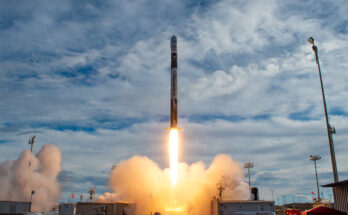by Bill Ostrove, Space Systems Analyst, Forecast International.
On June 27, a SpaceX Falcon 9 carrying a Dragon cargo spacecraft on its way to the International Space Station (ISS) broke apart shortly after launch. The launch vehicle lifted off at 10:21 a.m. EDT from Space Launch Complex 40 at the Cape Canaveral launch site.
The Dragon capsule, the seventh launched under NASA’s Cargo Resupply Services (CRS) contract, was carrying supplies to the ISS, including food, scientific equipment, and station hardware. One of the more important pieces of equipment being carried was the International Docking Adaptor-1 (IDA-1), part of a universal docking system being developed by NASA so more companies can take part in ISS operations. The Dragon also carried eight CubeSats for Planet Labs.
This launch failure represents the third loss of a cargo vessel carrying supplies to the ISS in the last eight months. Orbital ATK lost a Cygnus vehicle, while Roscosmos lost a Progress spacecraft. There are currently four different spacecraft designed to carry supplies to the ISS. One reason for having multiple types of resupply spacecraft is to ensure redundancy in case of failure. However, with three of the four experiencing failure in such a short period of time, there is some pressure on system operations. That said, ISS operators say there is enough food aboard the space station to last through the summer, and another Progress is due to launch this week, while a Japanese HTV will launch later this summer.
The loss is also a blow to SpaceX. The company will need to investigate the causes of this failure and work to prevent such losses in the future, which will take time. With two commercial cargo craft suffering losses in an eight-month period, members of Congress who are already opposed to the commercialization of space could use this as ammo against NASA’s commercial space plans. That will play out in the debate between NASA and Congress over funding levels for human space programs. In particular, NASA favors funding commercial crew vehicles being developed by Boeing and SpaceX, while Congress favors development of the Space Launch System and Orion. Because government work is an important source of revenue for SpaceX, the company could be financially hurt by government funding cuts.
Still, with 18 successful launches before the June 27 flight, SpaceX’s Falcon 9 has a 94.7 percent success rate. Therefore, the accident will have little effect on the Falcon 9’s marketability. Delays have been a bigger problem for SpaceX than reliability. Companies won’t stay away from SpaceX for fear of further failures, but they could stay away given that SpaceX already has a booked launch manifest – one that will be delayed by months of investigation into Saturday’s launch failure.
If there are no further launch failures, these issues are short-term problems. Most satellite operators (both government and commercial) want to have a choice of options for the launch of satellites. With United Launch Alliance (ULA) talking about eventually getting down to a single launch vehicle, the U.S. Air Force will need SpaceX to maintain competition. Most large commercial operators like SES and Intelsat talk about launch competition as well. For that reason alone, SpaceX will continue to get contracts. On top of that, the company continues to have a competitive price and a strong record of success despite the launch failure this weekend.
There could be a slight dip in SpaceX contracts, but over the long term, contracts and launches will continue.
A military history enthusiast, Richard began at Forecast International as editor of the World Weapons Weekly newsletter. As the Internet grew in importance as a research tool, he helped design the company's Forecast Intelligence Center and currently coordinates the EMarket Alert newsletters for clients. Richard also manages social media efforts, including two new blogs: Defense & Security Monitor, covering defense systems and international issues, and Flight Plan, which focuses on commercial aviation and space systems. For over 30 years, Richard has authored the Defense & Aerospace Companies, Volume I (North America) and Volume II (International) services. The two books provide detailed data on major aerospace and defense contractors. He also edits the International Contractors service, a database that tracks all the contractors involved in the programs covered in the FI library. More recently he was appointed Manager, Information Services Group (ISG), a new unit that encompasses developing outbound content for both Forecast International and Military Periscope.



